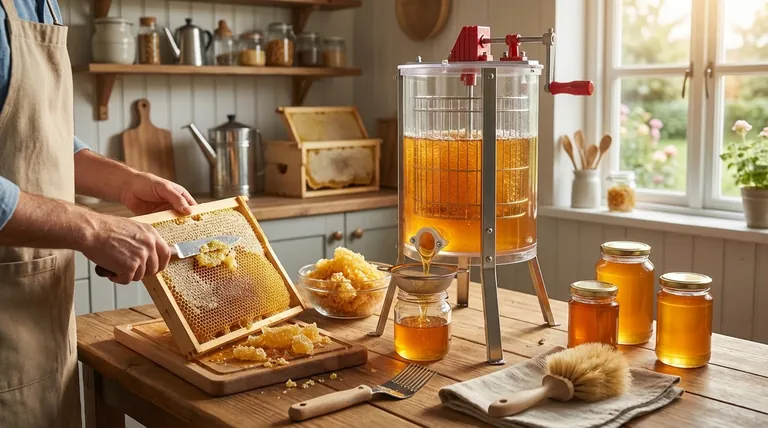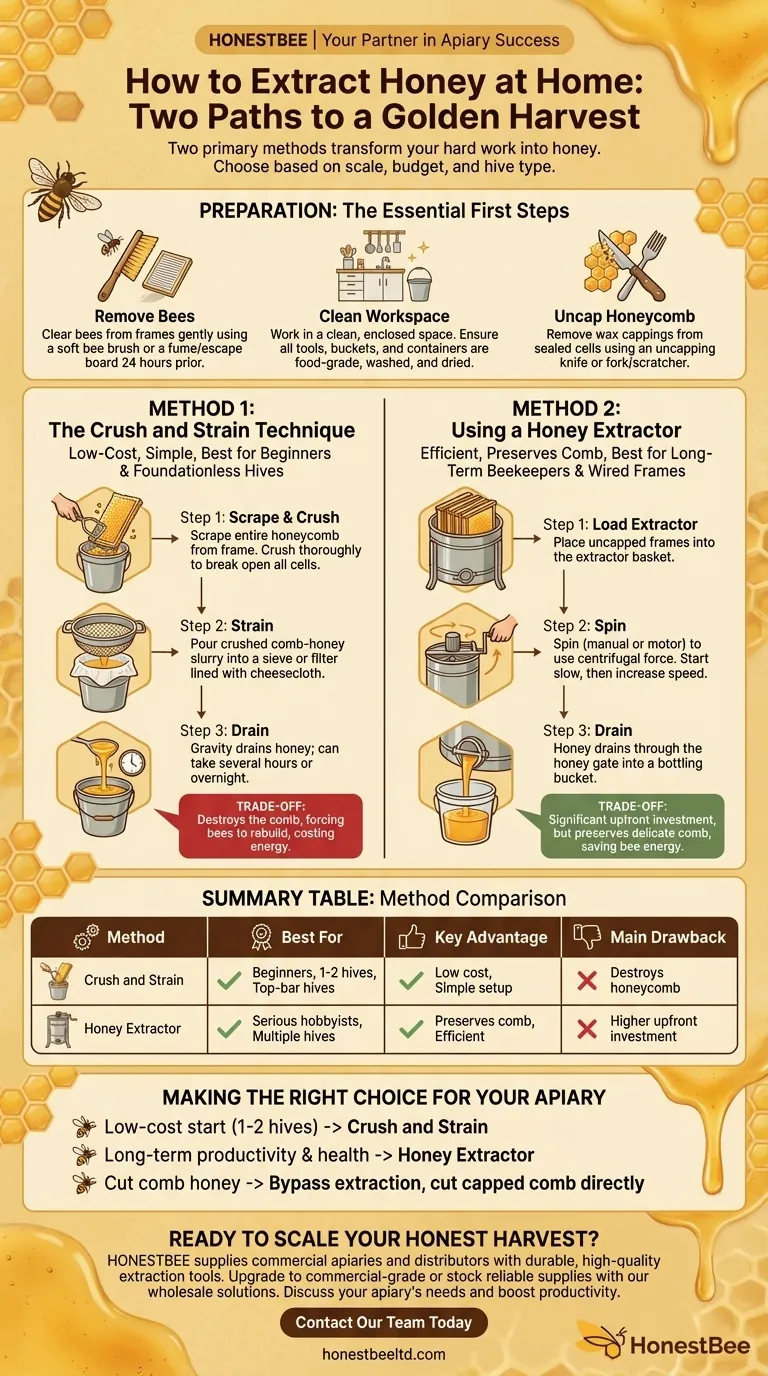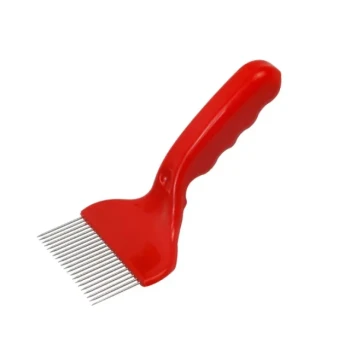Extracting honey at home is a rewarding process that transforms your hard work into a sweet, golden harvest. The two primary methods are the low-cost "crush and strain" technique, which is ideal for beginners, and using a centrifugal "honey extractor," which is more efficient for larger volumes and preserves the honeycomb for the bees to reuse. Your choice will depend on your budget, scale, and the type of frames in your hive.
The core decision in home honey extraction is choosing between the simple, low-cost crush and strain method that destroys the comb and the more expensive but efficient extractor method that preserves it. Preserving the comb saves your bees immense time and energy, making an extractor a worthwhile investment for any serious hobbyist.

Preparing for Extraction: The Essential First Steps
Before you can get to the honey, a few preparatory steps are critical regardless of which extraction method you choose. Your goal is to work cleanly and efficiently.
Removing Bees from the Frames
You must first clear the bees from the honey-filled frames, known as "supers." This can be done by gently sweeping them off with a soft bee brush or by using a fume board or escape board 24 hours prior to removal, which encourages the bees to leave the super on their own.
Creating a Clean Workspace
Honey is a food product, so cleanliness is paramount. Work in a clean, enclosed space like a kitchen to prevent contamination from dust or curious insects. Ensure all your tools, buckets, and containers are food-grade and have been thoroughly washed and dried.
Uncapping the Honeycomb
Bees seal their finished honey in cells with a thin layer of beeswax called "cappings." This wax must be removed to release the honey. Use an uncapping knife (which can be cold or electrically heated) or an uncapping fork/scratcher to carefully slice or scrape off this top layer of wax. Collect these cappings in a separate bucket or tank, as they still contain a good amount of honey.
Method 1: The Crush and Strain Technique
This is the oldest and most straightforward method of honey extraction. It requires minimal specialized equipment, making it perfect for first-time beekeepers or those with only one or two hives.
When to Use This Method
The crush and strain method is best suited for combs that are not built on a plastic or wired foundation. It's the go-to technique for top-bar hives or foundationless frames where preserving the comb is not a priority.
The Step-by-Step Process
After uncapping, scrape the entire honeycomb from the frame into a large, food-grade bucket. Using a clean potato masher or your hands, crush the comb thoroughly to break open all the honey cells.
Next, place a large sieve, a colander lined with cheesecloth, or a purpose-built honey filter over a second clean bucket. Pour the crushed comb-and-honey slurry into the filter. Gravity will do the rest, but it can take several hours, or even overnight, for all the honey to drain through.
Method 2: Using a Honey Extractor
A honey extractor is a machine that uses centrifugal force to sling honey out of the combs without destroying them. This is the standard for most beekeepers who use frames with foundation.
When to Use This Method
If you plan to keep bees long-term, an extractor is a wise investment. By preserving the delicate drawn-out comb, you save your bees a tremendous amount of energy. They can immediately begin refilling the comb instead of having to rebuild it from scratch.
The Step-by-Step Process
Place your uncapped frames vertically into the basket of the extractor. Begin spinning the handle (on a manual model) or turn on the motor at a low speed. Spinning too fast initially can cause the full combs to break under their own weight.
After extracting from the first side, flip the frames and spin again to extract from the other side. The honey flings out against the wall of the extractor drum, drips to the bottom, and can be drained through a tap or "honey gate" into a bottling bucket.
Understanding the Trade-offs
Neither method is universally superior; they serve different purposes and come with distinct compromises that you must consider.
Crush and Strain: Simplicity vs. Destruction
The primary advantage here is the low cost and simplicity. You don't need to buy an expensive extractor. However, the major drawback is that you destroy the comb, forcing your bees to expend significant resources (consuming about 8 pounds of honey to produce 1 pound of wax) to rebuild it.
Extractor: Efficiency vs. Investment
An extractor is highly efficient and preserves the comb, which is a massive advantage for the health and productivity of your colony. The clear downside is the significant upfront cost of the equipment, which may not be justifiable for a beekeeper with a single hive.
Filtration and Honey Quality
The crush and strain method, when filtered through a simple sieve, often leaves more pollen in the final product. This can result in a richer flavor and is what many people consider "raw" honey. An extractor paired with fine filters will produce a clearer, more polished-looking honey but may remove some of this pollen.
Making the Right Choice for Your Apiary
Ultimately, your decision should align with your specific goals, budget, and beekeeping philosophy.
- If your primary focus is a low-cost start with one or two hives: The crush and strain method is your most practical and economical starting point.
- If your primary focus is long-term productivity and colony health: Investing in a centrifugal extractor will save your bees energy and dramatically increase your efficiency over time.
- If your primary focus is producing cut comb honey: You will bypass these extraction methods and simply cut sections of capped comb directly from the frame for packaging.
Understanding these core methods empowers you to choose the right process for your scale, budget, and the well-being of your bees.
Summary Table:
| Method | Best For | Key Advantage | Main Drawback |
|---|---|---|---|
| Crush and Strain | Beginners, 1-2 hives, top-bar hives | Low cost, simple setup | Destroys honeycomb |
| Honey Extractor | Serious hobbyists, multiple hives | Preserves comb for bees, efficient | Higher upfront investment |
Ready to Scale Your Honey Harvest?
As a beekeeper, choosing the right equipment is key to your success and your colony's health. HONESTBEE supplies commercial apiaries and beekeeping equipment distributors with the durable, high-quality tools needed for efficient honey extraction. Whether you're a growing operation looking to upgrade to a commercial-grade extractor or a distributor stocking reliable supplies, we provide wholesale solutions to support your business.
Let's discuss your apiary's needs. Contact our team today to learn how our equipment can boost your productivity and support your bees' well-being.
Visual Guide

Related Products
- HONESTBEE 3-Frame Manual Acrylic Honey Extractor
- 6 Frame Manual Stainless Steel Honey Extractor Beekeeping Equipment
- Plastic Hand Crank 2 Frame Honey Extractor Low Price
- electric honey extractor honey centrifuge 3 frame honey extractor stainless steel honey frame extractor
- Stainless Steel 3 Frame Manual Honey Extractor Spinner for Bee Honey Extraction
People Also Ask
- What is the most common method for cleaning a honey extractor? Protect Your Honey & Equipment
- What is a fun and easy alternative to using a honey extractor for harvesting honey? Try the Crush and Strain Method
- What equipment is used for honey harvest? Essential Tools for Every Beekeeper
- How do you manually extract honey? Choose the Best Method for Your Hive
- How to extract honey by hand? A Guide to Crush & Strain vs. Manual Extractors



















